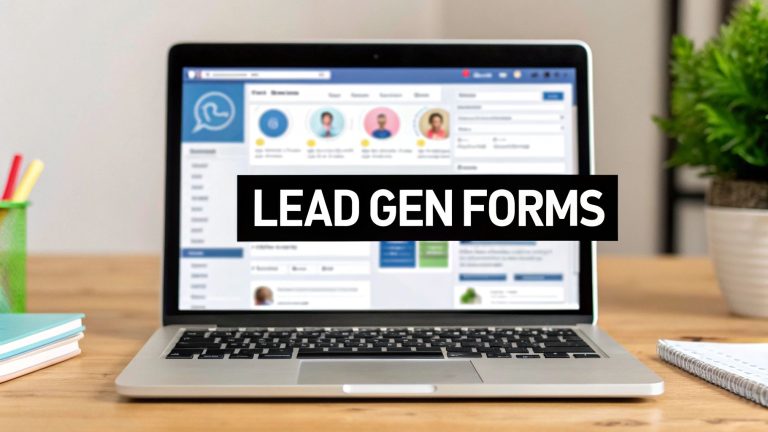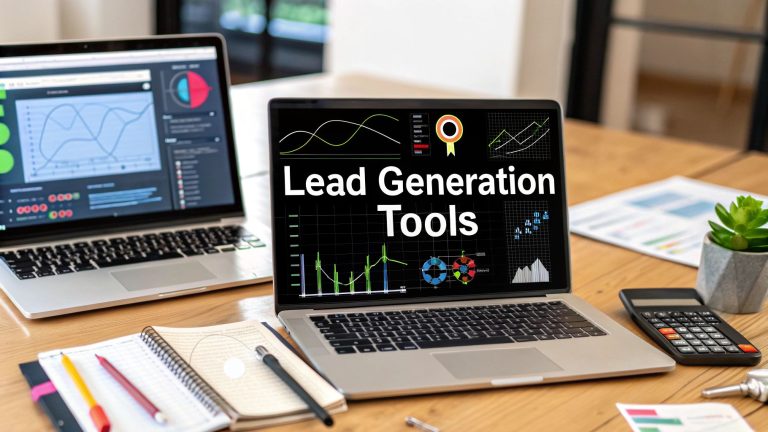MQL Definition Guide: Turn Browsers Into Buyers
Understanding The MQL Definition That Actually Works

Forget the dry, academic explanations. Let's get a practical MQL definition that you can actually use. Think of a car dealership. Countless people walk the lot just to browse. But then, someone schedules a test drive, asks specific questions about financing, and keeps revisiting that one car’s page on your website. Their behavior has changed. They are no longer a casual browser but a serious prospect. That person is your Marketing Qualified Lead (MQL).
Simply put, an MQL is a potential customer who has actively engaged with your marketing in a way that signals they are more likely to buy than other leads. This isn't just a fancy label; it's a crucial signal for your business. The key takeaway is that this definition isn't one-size-fits-all. A powerful MQL definition is built for your specific business, considering your industry, sales cycle, and ideal customer.
What counts as a strong signal for a software company (like attending a product demo webinar) is very different from an e-commerce brand (like abandoning a shopping cart with several high-value items). True qualification comes from pinpointing the exact actions that connect to sales-readiness for your company.
Separating Curiosity from Intent
The real work of an MQL system is telling the difference between genuine buying signals and simple curiosity. It’s about spotting the person actively researching a solution versus someone just downloading a free guide for later reading. An MQL is typically identified using a mix of behavioral, demographic, and historical data that, when combined, point to a lead's readiness to talk to sales.
This data-first approach ensures your marketing team isn't just tossing any name over the fence. Instead, they are handing off leads who have demonstrated legitimate interest. To build a system that works, your marketing and sales teams must agree on what these signals are. This alignment guarantees that the leads marketing nurtures are the exact prospects the sales team wants to connect with.
Here’s an example from HubSpot that shows how different engagement levels fit together.
This visual shows that an MQL is at a critical point in the journey—they've shown more interest than a standard lead but aren't quite ready for a direct sales pitch like a Sales Qualified Lead (SQL).
Why Getting Your MQL Definition Right Changes Everything
Nailing down what a Marketing Qualified Lead (MQL) means for your business isn't just a matter of semantics; it's a strategic decision that directly shapes your revenue. When companies have a fuzzy or nonexistent MQL definition, they unintentionally create a battleground between marketing and sales. Marketing might hit their numbers and celebrate a flood of new "leads," while the sales team gets bogged down chasing people who were just browsing with no real intent to buy.
This misalignment isn't just bad for morale—it's a direct drain on your resources. A loose definition clogs your sales pipeline with unqualified prospects, forcing your sales team to waste precious time and energy. But a sharp, well-defined MQL acts like a high-performance filter, ensuring only the most promising leads—those who have raised their hand and shown genuine interest—are passed along. This focus empowers sales to do what they do best: close deals.
The Mathematics of a Strong MQL Definition
The numbers don't lie: when it comes to leads, quality trumps quantity every single time. It might feel strange to aim for a smaller pool of MQLs, but the results speak for themselves. In many high-performing organizations, only 15-30% of initial leads ever earn the MQL title. These aren't just any leads; they are the ones with real potential.
This infographic shows just how dramatically conversion rates change when you get stricter with your MQL criteria.

As you can see, as the MQL volume goes down (because the rules are tighter), the conversion rates for both sales qualification and closed deals shoot up.
From High Volume to High Value
This pivot from a volume-first to a value-first mindset is where sustainable growth ignites. To better understand the performance gap, let's compare how MQLs stack up against unqualified leads across a few key metrics.
MQL vs Unqualified Lead Performance Comparison
A detailed comparison showing the performance differences between MQLs and general leads across key metrics
| Metric | MQLs | Unqualified Leads | Improvement Factor |
|---|---|---|---|
| Sales Conversion Rate | 10-15% | 1-3% | Up to 5x |
| Sales Cycle Length | 30-60 Days | 90+ Days | ~2x Faster |
| Lead Acceptance by Sales | 80-90% | 20-30% | ~3-4x Higher |
| Cost Per Acquisition (CPA) | Lower | Higher | More Efficient |
The table makes it crystal clear: MQLs aren't just slightly better; they perform on a completely different level. Focusing your team's energy on these high-potential leads results in faster sales, higher conversion rates, and a more efficient revenue engine.
Reports consistently show that leads properly identified as MQLs convert at a rate 3 to 5 times higher than their unqualified peers. This massive difference underscores the financial cost of a weak MQL definition. When you learn more about the fundamentals in our complete guide to what is lead qualification, you can start building this alignment. When marketing and sales agree on what makes a lead truly "sales-ready," you don't just fix a metric—you optimize your entire path to revenue.
Building MQL Criteria That Catch Quality Prospects
Defining a Marketing Qualified Lead (MQL) isn't an abstract exercise; it's about designing a practical filter. Think of it like a gold mining operation. Your job is to build a system that expertly separates the valuable nuggets (your ideal customers) from all the surrounding river sediment (everyone else). This requires a well-built set of criteria that looks beyond a single action, combining different data types to paint a full picture of a prospect's interest.
A strong framework doesn't rely on just one type of signal. Instead, it balances two key categories of information:
- Firmographic & Demographic Data: This is the “who” information. It includes hard facts like the company’s size, its industry, geographic location, and the lead's job title. These details help you confirm if the person fits your Ideal Customer Profile (ICP).
- Behavioral Data: This is the “what” information, tracking the specific actions a lead takes. This includes their engagement patterns, such as which emails they open, what content they download, how much time they spend on your pricing page, or if they keep visiting certain product feature pages.
The Power of Lead Scoring
The best way to merge these data points is through lead scoring. This is a system where you assign points to different attributes and actions. When a lead’s total score hits a specific number, they are automatically flagged as an MQL. For instance, a C-level executive from a target industry might get 25 points just for their profile. If they then download a case study (+15 points) and attend a webinar (+20 points), their total score of 60 could push them over the MQL finish line.
The following table breaks down how you might structure a lead scoring system. It shows how different criteria can be weighted to reflect their importance in identifying a high-quality lead.
| Criteria Category | Examples | Point Value | Threshold |
|---|---|---|---|
| Demographics | Job Title (C-Suite, VP), Industry (Target Sector) | 10-25 points | MQL if total score > 60 |
| Firmographics | Company Size (>500 employees), Revenue (>$50M) | 10-20 points | N/A (contributes to total) |
| High-Intent Behavior | Requested a Demo, Started a Free Trial | 30-40 points | N/A (contributes to total) |
| Engagement | Webinar Attendance, Case Study Download | 15-20 points | N/A (contributes to total) |
| Passive Interest | Email Open, Website Visit | 1-5 points | N/A (contributes to total) |
This scoring framework helps you systematically prioritize leads. A lead who requests a demo is clearly showing more buying intent than someone who simply opens an email, and their score should reflect that.
This screenshot from Salesforce shows a lead scoring model in action, with points assigned to different criteria.

As you can see, high-value actions are weighted more heavily, which helps ensure that the most engaged prospects rise to the top.
Aligning Marketing and Sales on Criteria
The most important step is getting your marketing and sales teams to agree on these criteria together. If this collaboration doesn't happen, you risk creating a system that marketing loves but sales finds useless. Sales has direct, firsthand knowledge of which lead characteristics actually turn into closed deals. Their feedback is crucial for building a scoring model that works.
Schedule regular meetings to review MQL performance. Ask direct questions: Are the leads we're sending over actually converting? Are there common traits among the leads that get stuck? This continuous feedback loop is what turns a static MQL definition into a dynamic, revenue-driving engine that gets better over time.
MQL Programs In Action: What Success Looks Like
Theories and definitions are a great starting point, but seeing a sharp MQL definition work in the real world is what makes the concept truly stick. Successful companies don’t just write down rules for what makes a good lead; they build active systems that recognize customer intent across different interactions. These systems turn abstract criteria into real, measurable results.
Think of it like a smart filter that adapts to different situations, whether it's a big product launch or the usual seasonal buying habits. Let's walk through a couple of common scenarios to see how a person goes from a simple contact to a sales-ready MQL.
Capturing Initial Interest with Facebook Lead Forms
Imagine a small business running a campaign using Facebook Lead Forms. They're offering a free, downloadable guide on social media marketing. This is a classic top-of-funnel move. When someone submits their information here, they're showing a flicker of interest, but they aren't necessarily ready to buy anything. This is where their qualification journey begins.
The form itself is designed for simplicity to get as many submissions as possible. This creates a wide pool of contacts for the marketing team to start engaging with.
Nurturing and Scoring with LeadSavvy Pro
Once that form is submitted, the real work begins. Instead of manually downloading CSV files every few hours, the business uses a tool like LeadSavvy Pro to instantly pull that new lead's information into their system. This is where the MQL criteria come to life. The system starts watching how the lead behaves.
Let's follow the journey of that person who downloaded the guide. Over the next two weeks, they:
- Open 3 of the 5 emails in the automated follow-up sequence.
- Click through to read two different blog posts linked in those emails.
- Spend more than 60 seconds looking at the company’s pricing page.
- Download a detailed case study about a similar company's success story.
Each of these actions is like a clue, adding points to their lead score. The initial form submission might have been worth 10 points, but all this engagement pushes their score past the 60-point threshold the company set.
The moment their score hits that number, they are automatically upgraded to an MQL and flagged for the sales team. This is a core part of effective automated lead nurturing, making sure no genuinely interested person slips through the cracks. The system successfully spotted someone moving from casual curiosity (downloading a free guide) to active consideration (checking pricing and proof). That transition is the entire goal of a well-run MQL program.
MQL Mistakes That Kill Your Lead Generation

Even with a thoughtful MQL definition, many companies stumble into common traps that damage their lead generation. These errors don't just hurt conversion rates; they can create a major disconnect between marketing and sales, disrupting the entire revenue process. Pinpointing these pitfalls is the first step toward building a strong program that delivers high-quality opportunities consistently.
One of the worst mistakes is setting the MQL bar too low. It's an easy trap to fall into because it makes marketing's lead numbers look fantastic. But in reality, you're just opening the floodgates. This swamps the sales team with a wave of uninterested leads, forcing them to waste precious time on prospects who are nowhere near ready for a sales call. The outcome? Sales acceptance rates drop, and trust in marketing's efforts begins to fade.
The Problem of Being Too Strict
On the other hand, making your MQL criteria too strict can be just as damaging. While it ensures every lead passed to sales is practically a sure thing, it also means you’re likely ignoring a huge pool of potential customers. A prospect who is genuinely interested but hasn't downloaded that one specific whitepaper is left behind. This approach starves your sales pipeline, leaving reps with too few leads to hit their targets.
The goal is to find a healthy middle ground. Your MQL definition should identify strong interest based on a "preponderance of the evidence," not demand proof "beyond a reasonable doubt."
The Dangers of Static Criteria
Maybe the most frequent mistake is creating an MQL model and then never touching it again. Your market isn't static—customer behaviors shift, and your own business goals change. An MQL framework built last year might be completely misaligned with today's reality.
Here are a few critical errors that come from using outdated criteria:
- Fixating on demographics: A lead might look perfect on paper (right company size, ideal job title) but show zero signs of active interest. Relying only on firmographics ignores the most important factor: buying intent.
- Ignoring sales feedback: Your sales reps are on the front lines every day. They have direct insight into which leads convert and which ones go cold. Failing to listen to them means you’re not learning from your real-world results.
- Failing to adapt: The actions that signal a hot lead will change over time. When you launch a new product, for instance, the relevant engagement signals will be different. A program that can’t adapt will quickly lose its effectiveness.
Your MQL definition needs to be a living document, one that is regularly reviewed and updated with fresh data and insights from both the marketing and sales teams.
Advanced MQL Strategies Using Smart Technology
Moving beyond basic lead scoring, today’s best MQL programs are powered by smart technology that pinpoints qualified prospects with impressive accuracy. Artificial intelligence and machine learning are no longer concepts from the future; they are the real engines driving modern lead qualification. These systems analyze huge amounts of behavioral data in real-time to create predictive scoring models. Instead of a lead having a static score, their qualification level changes with every action they take (or don't take), giving you a much clearer picture of their intent to buy.
This technology is the core of modern marketing automation platforms. These tools track complex buyer journeys across dozens of touchpoints—from website visits and email clicks to social media engagement and content downloads. By connecting all these dots, the system can automatically adjust a lead's score, providing a dynamic and up-to-date assessment of their readiness. This ensures that your MQL definition isn't a rigid rule but a living benchmark that adapts to prospect behavior.
Unifying the Tech Stack for Better Results
A key part of this advanced approach is making sure your marketing automation platform and your Customer Relationship Management (CRM) system work together perfectly. When a lead’s score hits the MQL threshold, they should instantly and automatically be sent to the sales team's workflow. This automated handoff removes the risk of top-quality leads falling through the cracks because of slow manual data entry. It keeps the momentum going while the lead's interest is at its peak.
This screenshot from HubSpot shows how marketing automation platforms can help you visualize and build these complex workflows.
This visual demonstrates how you can set up automated rules to trigger actions, like assigning a lead to a sales rep the moment they become an MQL, guaranteeing a quick and efficient handoff.
Smarter Prospecting and Profiling
Advanced technology also unlocks more sophisticated ways to qualify leads. Two powerful methods stand out:
- Lookalike Modeling: Think of this as a digital matchmaker. AI analyzes the characteristics and behaviors of your best, highest-value customers. It then scans your new and existing leads to find prospects who share those same winning traits, effectively predicting who is most likely to become a great customer.
- Progressive Profiling: Instead of greeting a new lead with a long, intimidating form, progressive profiling builds their profile over time. With each interaction, the system asks for just one or two new pieces of information. This gradual approach gathers deep insights without creating a poor experience for the prospect.
Finally, the most important piece of the puzzle is closed-loop reporting. This means tracking a lead from their very first click all the way to a closed deal. By analyzing which MQLs actually turn into paying customers, you can constantly refine your MQL definition. This data-driven feedback loop ensures your qualification criteria get smarter and more effective over time, ultimately improving your marketing ROI.
Measuring And Optimizing Your MQL Performance
Creating a solid MQL program isn't a "set it and forget it" task. It's more like navigating a ship by the stars—without fixed points to measure against, you're just drifting. Your metrics are those stars, and you need to constantly check them to adjust your course.
To know if your MQL definition is truly effective, you must look past the total number of MQLs you generate. The real story lies in what happens after a lead is labeled an MQL. A successful program requires careful monitoring of the entire journey, from that initial interest to a signed deal.
Tracking The Metrics That Matter
To get a clear picture, you need to focus on key performance indicators (KPIs) that connect marketing efforts directly to business growth. You can learn more about the most important lead generation KPIs in our detailed guide, but for evaluating your MQLs, these three are non-negotiable:
- MQL-to-Customer Conversion Rate: This is the ultimate report card. What percentage of the leads you call "marketing qualified" actually end up buying something? If this number is low, it’s a big red flag that your qualification criteria are off.
- Time-to-Conversion: How long does it take for an MQL to become a customer? A shorter sales cycle often means you're attracting higher-quality, more motivated leads who are ready to act.
- Average Deal Size by Lead Source: Are the MQLs from your blog posts leading to bigger deals than those from your paid ads? This data is crucial for deciding where to invest your marketing budget for the best return.
The Power of Attribution and Regular Reviews
Knowing which marketing channels deliver your most valuable MQLs is critical. Was it that webinar you hosted last month or the new guide you published on your blog? Proper attribution tracking tells you exactly what’s working, so you can double down on your most effective strategies.
Finally, treat your MQL definition like a living document, not a stone tablet. Schedule regular meetings with both the marketing and sales teams. Get together to analyze the data and, just as importantly, gather direct feedback. Are sales reps constantly saying that leads from a certain campaign are unprepared for a sales call? That kind of on-the-ground insight is priceless.
By combining hard conversion data with honest sales feedback, you can continuously fine-tune your qualification criteria. This iterative process ensures your MQL definition stays aligned with your market and customer behavior, leading to a healthier sales pipeline and better results over time.
Ready to stop manually downloading leads and start reacting the moment they show interest? LeadSavvy Pro instantly syncs your Facebook leads to your CRM or Google Sheets, so you can focus on nurturing prospects, not managing spreadsheets. Start your free plan today and see the difference.







